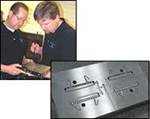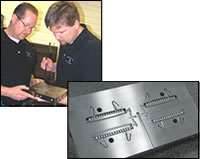For Mold Shops, Machining To Zero Means There Is Nothing To Hold Them Back
Advanced machining technology enables mold shops to produce cores and cavities without leaving extra stock. Following this trend of “machining to zero” will help make mold production more competitive.
Shops that produce plastic injection molds are discovering that today’s metalworking technology allows them to bypass some of the most time-consuming and labor-intensive aspects of mold production. This technology is a combination of fairly recent developments, which are summarized in the box entitled “Strategic Synergy” below. This combination of advancements in machine tools, programming software, toolholders, end mills and other accessories enables machining of hardened 3D mold surfaces that are so accurate and so smooth that grinding or polishing by hand is greatly reduced or eliminated. Because the final machining occurs after heat treating, a step or two for hardening can be skipped. Many features that formerly required one or more operations by EDM (electrical discharge machining) can be produced in one setup on a mill. Shutoff areas can be machined to mate so perfectly that spotting the mold takes hours instead of days.
“Machining to zero” may be a baffling term at first glance. Some mold shops call it “net machining,” “machining to the model,” or “cutting to zero.” Indeed, the concept centers around techniques that make leaving excess stock unnecessary when machining 3D mold surfaces. Instead of intentionally applying toolpath offsets to leave 0.001 to 0.003 inch of stock on surfaces, no stock—a zero amount—is left behind. In fact, the same technology that makes this feasible also enables machining to a negative stock condition, a concept closely related to machining to zero but not as widely accepted. The idea is to remove an extra 0.0004 to 0.0008 inch from mold surfaces. On shutoff areas, the resulting gap is not large enough to allow most plastic materials to flow through and create flash, but it is large enough to prevent the edges at parting lines from making contact when the mold closes. This prevents wear along these edges. The gap also allows the mold to vent more evenly and efficiently, proponents say.
A mold machined this way could go from the machine tool to the plastic injection press and produce an acceptable molded part with the first shot. No polishing. No hand fitting. No spotting. Although this ideal is achievable and should be the ultimate goal for mold shops, the main benefits of not allowing excess stock are a reduction in the labor hours required to produce a mold, a reduction in overall mold-production leadtime, and a significant improvement in mold performance.
Conventional machining technology and traditional mold-building practice did not permit machining to zero. Mold shops routinely left extra material on cavities, cores and shutoffs because they had to. The excess stock ensured that sufficient material would be available for benching, polishing and other adjustments without exceeding the dimensional tolerances on the mold. Likewise, excess stock acted as a safety factor to compensate for the margin of error imposed by the limitations of conventional technology.
The limitations include:
- Errors in the volumetric accuracy of the machine tool.
- Spindles that vibrate excessively, run off-center or “grow” as they absorb heat.
- Runout in cutting tools and toolholders.
- Runout in spindle rotation.
- Excessive chordal deviation in the programmed tool path.
- Sources of vibration in the machine tool structure, tooling and programmed cutter moves.
Of course, leaving extra stock means that it must be removed later. This practice inevitably builds in hours of handwork and spotting. This “unnecessary” time and cost affect the competitiveness of the mold builder, especially when quoting against low-wage mold builders overseas. The added hours stretch out leadtimes, which makes rapid, timely delivery problematic. Handwork and custom fitting also make it likely that a mold will need adjusting and tweaking in the production press, thus creating delays and adding cost for the customer.
By taking this time and effort out of mold production, machining to zero/negative stock helps neutralize the cost advantage of molds from overseas builders. When the “hard” costs of procuring the mold, having it shipped from abroad, checked, and possibly reworked upon receipt are added to the “soft” costs of coping with a language barrier, dealing with time-zone differences, shipping delays, and difficulty in handling engineering or design changes, the domestically produced mold should have a compelling advantage. Keeping mold production onshore also reduces the risk of losing control of intellectual property—and this value may be inestimable.
Beyond High Speed Machining
In many ways, machining to zero is an extension of the high speed machining process. The essence of HSM is taking light cuts at high feed rates with closely spaced stepovers. High spindle speeds are required to reach optimum chip loads at the specified depths of cut. Machining to zero borrows and builds on all of these techniques.
Machining to zero, however, goes several steps further. It calls for very tight geometric tolerance. To achieve the accuracies that machining to zero or to negative stock requires, all of the technology components must work together. Todd Schuett, of Creative Technologies (a machining technology provider) and a proponent of this approach, describes it this way: “The accuracy of the end product relies on accuracy each step of the way. Efficient program execution demands better machine and tooling performance. Tool life demands better programming and machine performance. Efficient machine operation demands tight, accurate programs to guide the motion and tools that are durable and accurate. The three components are inescapably intertwined, each relying on the others for its own success.”
Although the techniques of machining to zero or machining to negative stock have proven to be most advantageous with small to medium-sized molds, these techniques are starting to be applied to larger molds such as those for automotive interior panels and lenses for lighting assemblies.
Four Successful Users
Each of the following four articles profiles a mold shop that has adopted the machining-to-zero (or negative stock) concept. All of these shops follow the same basic principles of its application. Each shop has chosen different vendors for the technology, showing that the concept is not the pet project or brainchild of a narrow set of suppliers. Moreover, each shop has implemented the concept differently and has had unique experiences along the way.
The focus of each shop profile is on a different aspect of the concept. The profile of Eclipse Mold raises a discussion of machine tool characteristics. The profile of Ameritech delves into issues regarding toolholders, cutting tools and related components. The profile of SurKut highlights considerations regarding CAM software for CNC programming. Finally, the profile of Pro Mold looks at managing a workforce in the transition to machining to zero. Although the technical side of machining to zero is challenging, the people side of it cannot be underestimated or neglected.
Like these four shops, other mold shops must learn to compete on the basis of technology. Methods of mold production that reduce labor content deflate the importance of low wages for a cost advantage. Other factors, such as being closer to the customer and more responsive to special needs, can be leveraged to win orders. Technology is an equalizer that helps take the tilt out of the playing field, so to speak.
The success of the mold shops that have embraced machining to zero should be instructive to all machine shops. North American mold shops are clearly reviving their prospects in the face of intense global competition. They provide a model for revitalization that just about any company in metalworking can learn from and find encouraging.
Related Content
How to Accelerate Robotic Deburring & Automated Material Removal
Pairing automation with air-driven motors that push cutting tool speeds up to 65,000 RPM with no duty cycle can dramatically improve throughput and improve finishing.
Read MoreRead Next
The Hard Milling Imperative
Hard milling allows mold components to be machined in the hardened state, thus skipping several expensive and time-consuming processes such as electrical discharge machining and hand polishing.
Read MoreInside Machineosaurus: Unique Job Shop with Dinosaur-Named CNC Machines, Four-Day Workweek & High-Precision Machining
Take a tour of Machineosaurus, a Massachusetts machine shop where every CNC machine is named after a dinosaur!
Read MoreIMTS 2024: Trends & Takeaways From the Modern Machine Shop Editorial Team
The Modern Machine Shop editorial team highlights their takeaways from IMTS 2024 in a video recap.
Read More






















.jpg;maxWidth=300;quality=90)




